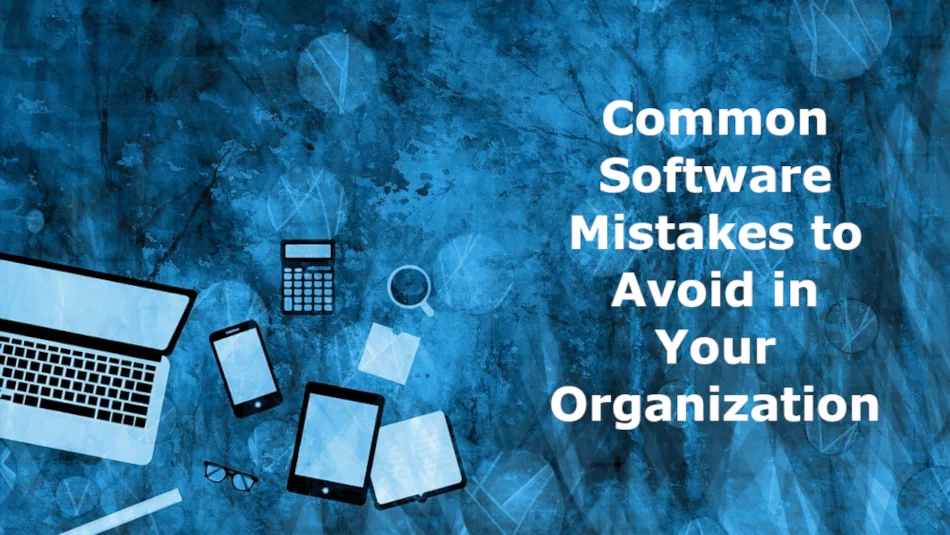In today’s digital age, software plays a crucial role in the success of any organization. Whether it’s for managing operations, enhancing customer experience, or driving innovation, software solutions are indispensable. However, many organizations make common mistakes in their software development and implementation processes that can hinder effectiveness and lead to significant setbacks. This blog post highlights six common software mistakes and provides practical solutions to avoid them.

1. Inadequate Requirements Analysis
One of the most fundamental mistakes organizations make is failing to conduct a thorough requirements analysis before starting a software project. This step is critical for understanding and documenting the specific needs and goals of the software. Without a clear requirements analysis, the software may end up misaligned with business objectives, leading to increased costs, project delays, and unsatisfactory outcomes.
To avoid this mistake, involve all relevant stakeholders in the requirements-gathering process. Clearly document the business needs, user expectations, and technical specifications. Using tools like use cases, user stories, and requirement management software can help ensure that the requirements are well-defined and understood by all parties involved.
2. Poor Project Management
Poor project and performance management can significantly derail the success of software projects within an organization. Ineffective project management often stems from inadequate planning, vague objectives, and poor communication among team members. This can result in missed deadlines, budget overruns, and compromised quality of the final product. Without a structured approach to managing tasks and resources, projects can quickly fall apart, leading to frustration and loss of productivity. Effective project management involves setting clear goals, defining roles and responsibilities, and using the right tools to monitor progress and facilitate collaboration. Regular updates and reviews are crucial to ensure that the project stays on track and any potential issues are addressed promptly.
In the realm of performance management, overlooking the importance of tracking and evaluating employee performance can have detrimental effects on an organization’s productivity and morale. Examining a relevant Performance Management Software roundup helps you implement solutions that offer a comprehensive way to monitor, assess, and improve employee performance systematically. These tools enable managers to set performance benchmarks, provide real-time feedback, and identify areas for improvement. By integrating performance management software, organizations can ensure that employees are aligned with the project goals and organizational objectives. This not only enhances individual performance but also fosters a culture of continuous improvement and accountability. In summary, leveraging performance management software can help organizations avoid the pitfalls of poor project.
3. Neglecting User Training
Even the most advanced and well-designed software can fail if end-users are not adequately trained. Neglecting user training can result in low adoption rates, inefficiency, and an increased number of support requests. Users need to feel comfortable and confident using the new software to leverage its full potential.
Develop comprehensive training programs tailored to different user groups within the organization. Offer a mix of training methods, including hands-on sessions, video tutorials, and user manuals. Providing ongoing support and creating user-friendly documentation can also help users navigate the software and troubleshoot common issues independently.
4. Insufficient Testing
Testing is a critical phase in the software development lifecycle, yet it is often rushed or inadequately performed. Insufficient testing can lead to the release of software with bugs, system crashes, and security vulnerabilities, which can have severe consequences for the organization.
Establish a robust testing process that includes various types of testing, such as unit testing, integration testing, system testing, and user acceptance testing. Automated testing tools can help streamline the testing process and ensure thorough coverage. Additionally, involving end-users in the testing phase can provide valuable feedback and help identify usability issues before the software goes live.
5. Overlooking Maintenance and Updates
Once software is deployed, the work doesn’t stop there. Regular maintenance and updates are essential to ensure the software remains secure, functional, and up-to-date with the latest features and improvements. Overlooking this aspect can lead to security risks, performance issues, and outdated functionality.
Schedule regular maintenance checks and stay updated with the latest software versions. Implementing a proactive monitoring system can help identify performance bottlenecks and potential issues early. Keeping the software well-maintained not only enhances its longevity but also ensures it continues to meet the evolving needs of the organization.
6. Ignoring Data Security
In an era where data breaches and cyber threats are rampant, ignoring data security is a critical mistake. Failing to implement strong data security measures can result in data breaches, legal consequences, and a loss of trust from customers and stakeholders.
Develop a comprehensive security policy that covers data encryption, access controls, and regular security audits. Educate employees on best practices for data security and the importance of adhering to security protocols. Implementing multi-factor authentication, firewalls, and intrusion detection systems can also help protect sensitive data from unauthorized access and cyberattacks.
Avoiding these common software mistakes is crucial for the success of your organization’s software projects. By conducting thorough requirements analysis, implementing effective project management practices, providing adequate user training, ensuring sufficient testing, maintaining regular updates, and prioritizing data security, you can enhance the efficiency and effectiveness of your software solutions.
Addressing these mistakes not only helps in achieving project goals but also ensures that the software delivers long-term value to the organization. Embrace best practices and foster a culture of continuous improvement to stay ahead in the competitive landscape of software development and implementation.


